Start learning 50% faster. Sign in now
B lives in an even numbered flat on lowermost floor i.e. B lives on floor ground floor in flat 2. Z lives in an even numbered flat on floor number 2. B and C live on same floor. P lives immediately above C and the numbers of their flats is same. So, Now, C either lives immediate west or east of B which means P either lives in flat 3 or flat 1. So, we have two possibilities. Case I: When C and P live on flat – 3: 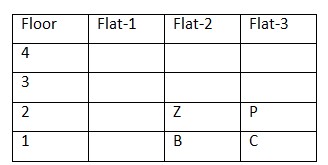 Case-2 When C and P live on Flat-1
Case-2 When C and P live on Flat-1 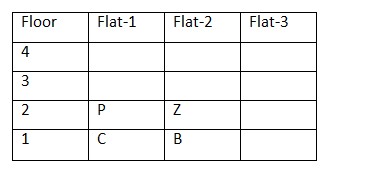 R and A live on same floor. X lives to the immediate west of R. R lives immediately below the vacant flat and the flat number of vacant flat and R is same. A lives in flat –1. There is one floor between R and Q. Now, R lives immediately below vacant flat so, the vacant flat must be in topmost floor. Case I: When C and P live on flat – 3:
R and A live on same floor. X lives to the immediate west of R. R lives immediately below the vacant flat and the flat number of vacant flat and R is same. A lives in flat –1. There is one floor between R and Q. Now, R lives immediately below vacant flat so, the vacant flat must be in topmost floor. Case I: When C and P live on flat – 3: 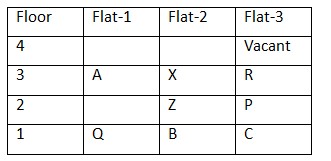 Case II: When C and P live on flat – 1
Case II: When C and P live on flat – 1 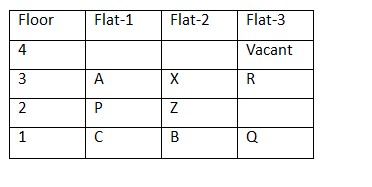 D lives somewhere above Y in same flat number, but not on flat 3. Now, we cannot fix D and Y in same flat number in case II, so, case II is invalid. The final arrangement is as follows:
D lives somewhere above Y in same flat number, but not on flat 3. Now, we cannot fix D and Y in same flat number in case II, so, case II is invalid. The final arrangement is as follows: 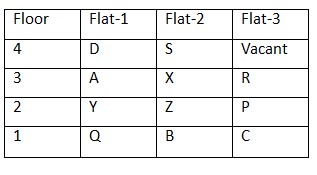
Equalisation of educational opportunity is provided in ____________ of Indian Constitution.
Assertion (A): State board examinations are not conducted simultaneously across India.
Reason (R): Different states have varying syllabi and exam...
Which of the following situations would the best for maximum transfer of learning?
You want to develop cooperation and team spirit in students? Which activities would you propose?
A teacher collects and reads the work in class VII, then plans and adjusts the next lesson to meet the student's needs. He is doing:
_______ is the apex institution involved in the planned and coordinated development of the teacher education system in the country.
If you want to improve the ability to observe in children, which of the following would you recommend?
Which one of the following is the most important elements in teaching?
If a teacher gives scores to correct responses in a class-test and enlists total marks of each learner, he/she has done:
For modifying teaching behaviour, which of the following strategies have been supported by research evidence?